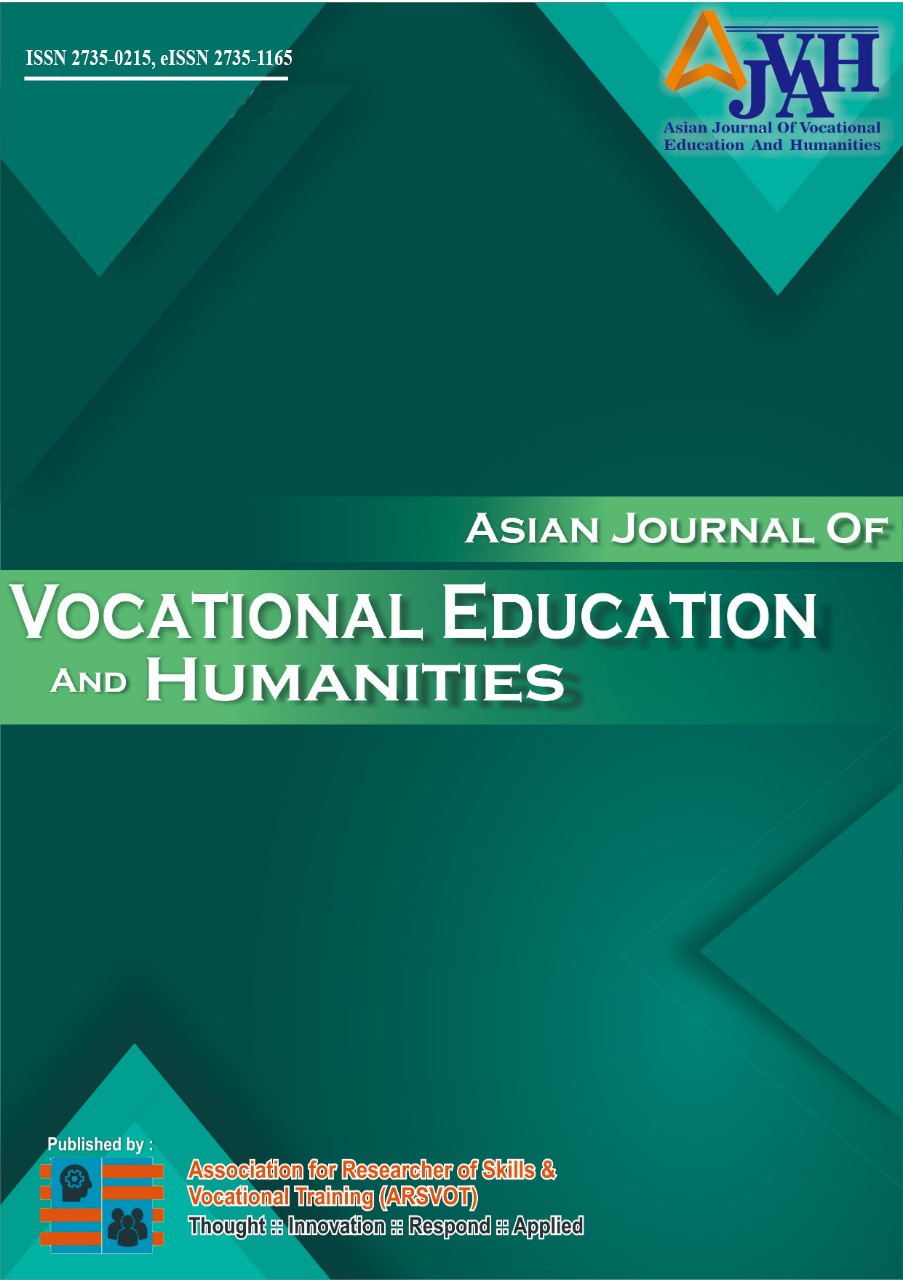THE INFLUENCE OF INNOVATIVE CHARACTERISTICS AND WORK READINESS ON EMPLOYABILITY OF TVET STUDENTS IN SOUTH-SOUTH NIGERIA UNIVERSITIES
DOI:
https://doi.org/10.53797/ajvah.v6i2.2.2025Keywords:
Innovative Characteristics, Work Readiness, Technical and vocational education and training.Abstract
This study investigated the influence of innovative Characteristics and Work Readiness on Employability of Technical and Vocational Education and Training (TVET) students. A correlational research design was used, with a sample of 594 participants (students) which was randomly selected across three Federal Universities in South-South, Nigeria. Structured questionnaires was used to collect data from TVET students. Pearson Product Moment Correlation Coefficient (PPMCC) and simple linear regression were used to for data analyses. Innovative Characteristics were found to influence employability of TVET students. Also, Work Readiness were found to influence employability of TVET students. One of the recommendations made for the study is that there is need of more effective intervention programmes or elective courses in TVET programmes so as to promote innovative characteristics and work readiness on employability upon graduation. This should equip TVET students with requisite skills leading to high rate of employability upon graduation.
Downloads
References
Ahmid, S.S., Tiew, C. C., & Abdullah, M. N.L. (2023). The influence of innovative characteristics, work readiness and vocational self-concept on employability of vocational college students. International Journal for Research in Vocational Education and Training (IJRVET), 10 (3), 288-317. https://doi.org/10.13152/ IJRVET.10.3.3.
Akhuemonkhan, I. A. & Raimi, L. (2013). Impact of quality assurance on Technical and Vocational Education and Training (TVET) in Nigeria. Retrieved on 3/6/2014 fromwww.iveta.org/Resources/Documents/about/.../Akhuemonkhan.pptx
Altinişik, H. Z., Adigüzel, T., & Gençer, Y. G. (2023). Adaptation of youth innovational skills measurement tool for Turkish usage. Kastamonu Eğitim Dergisi, 31(1), 155–164. https://doi.org/10.24106/kefdergi.1246467
Bryne, C. (2020). What determines perceived graduate employability? Exploring the effects of personal characteristics, academic achievements and graduate skills in a survey experiment. Studies in Higher Education, 47(1), 1–18, https://doi.org/10.1080/03075079.2020.1735329
Caballero, C. L., Walker, A., & Fuller-Tyszkiewicz, M. (2011). The work readiness scale (WRS): Developing a measure to assess work readiness in college graduates. Journal of Teaching and Learning for Graduate Employability, 2(2), 41–54, https://doi.org/10.21153/jtlge2011vol2no1art552
Chell, E., & Athayde, R. (2009). The identification and measurement of innovative characteristics of young people. NESTA Making Innovation Flourish, 1–43. https://eprints.kingston.ac.uk/id/eprint/5985/2/Chell-E-5985.pdf
Federal Republic of Nigeria (FRN, 2013). National Policy on Education, (6th ed). Lagos: NERDC Press
Ghavifekr, S., & Radwan, O. (2021). The effect of career management skills on career development abilities: Perspectives from tvet college students. MOJEM: Malaysian online journal of educational management, 9(3), 78–92. https://borneojournal.um.edu.my/index.php/MOJEM/article/ view/30573/13112
Gunawan, W., Creed, P. A., & Glendon, I. (2018) Development and initial validation of a perceived future employability scale for young adults. Journal of Career Assessment, 27(4), 610–627. https:// doi.org/10.1177/1069072718788645
Ishar, M. I. M., Derahman, W. M. F. W., & Kamin, Y. (2020). Practices and planning of ministries and institutions of technical and vocational educational training (TVET) in facing the industrial revolution 4.0 (IR 4.0). Malaysian Journal of Social Sciences and Humanities, 5(3), 47–50. https://doi.org/10.47405/mjssh.v5i3.374
Jaafar, S. N., Zakaria, N., & Rasheid, N. A. (2018). Career choice and employability skills for vocational college students. Journal of Physics: Conference Series, 1049(1), 1–8. http://doi.org/10.1088/1742-6596/1049/1/012050
Jiang, P. (2022). Phenomenon of employment anxiety in higher vocational colleges and its influence on students' employability. psychiatria danubina, 34(1), 277–278. https://hrcak.srce.hr/file/401266
Lau, P. L., Chung, Y. B., & Wang, L. (2019). Effects of a career exploration intervention on students' career maturity and self-concept. Journal of Career Development, 48(4), 311–324. https://doi.org/10.1177/0894845319853385
Li, W. (2021). The influence of the integration of innovation and entrepreneurship education and professional education on the employment ability of vocational college students. Information Processing and Advanced Education, 314–318. https://do
Luo, Z., Wang, S., & Wang, Z. (2022). The impact of college students' frustration tolerance on employment anxiety: The mediating role of coping styles. 8th International Conference on Humanities and Social Science Research (ICHSSR 2022), 850–855. Atlantis Press. https://doi.org/10.2991/assehr.k.220504.156.
Maigida, J., & Raymond, E. (2014). Training for skill acquisition: an antidote for effective poverty reduction in Nigeria. Sokoto Educational Review, 15(1), 10-10.
Mari, T. S., Srirangam S., Gunasagaran, S., Kuppusamy, S., & Ang, F. L. (2019). Architecture graduate work readiness: The gap between learning and employability. Journal of Physics, 636, 1–9, https:// doi.org/10.1088/1757-899X/636/1/012010
Masri, N., Abdullah, A., Asimiran, S., & Zaremohzzabieh, Z. (2021). Relationship between engagement in learning entrepreneurship education and entrepreneurial intention among vocational college students. Journal of Social Sciences & Humanities, 29(1),19–38. https://doi.org/10.47836/pjssh.29.S1.02
Massetor, N. A., Zulfadli, M., & Marian, M. F. (2021). K-workers practice in increasing graduate employability to overcome the challenges of the fourth industrial revolution. Research and Innovation in Technical and Vocational Education and Training, 1(1), 225–231. https://publisher.uthm.edu.my/ periodicals/index.php/ritvet/article/view/261
Paadi, K. (2014). Perceptions on employability skills necessary to enhance human resource management graduates prospects of securing a relevant place in the labour market. European Scientific Journal, 129–143. https://core.ac.uk/download/pdf/328024466.pdf
Prikshat, V., Kumar, S., & Nankervis, A. (2019). Work-readiness integrated competence model: conceptualisation and scale development. Education+Training, 49(4), 277–289. https://www.emerald.com/insight/content/doi/10.1108/ET-05-2018-0114/full/html.
UNESCO (2013). Shanghai Update, Issue No. 1, June 2013. Bonn: UNESCO-UNEVOC. Retrieved from http://www.unesco.org/new/fileadmin/ MULTIMEDIA/HQ/ED/pdf/shanghaiupdateJune2013.pdf.
Watts, A. G. (2006). Career development learning and employability. The Higher Education Academy. https://www.advance-he.ac.uk/knowledge-hub/career-development-learning-and-employability.
Zhang, D. (2021). Impacts of credit constraints on innovation propensity and innovation performance: Evidence from China and India. Asia-Pacific Journal of Accounting & Economics,
Downloads
Published
How to Cite
Issue
Section
License
Copyright (c) 2025 Samuel Osamede Ogbebor

This work is licensed under a Creative Commons Attribution-NonCommercial-ShareAlike 4.0 International License.


